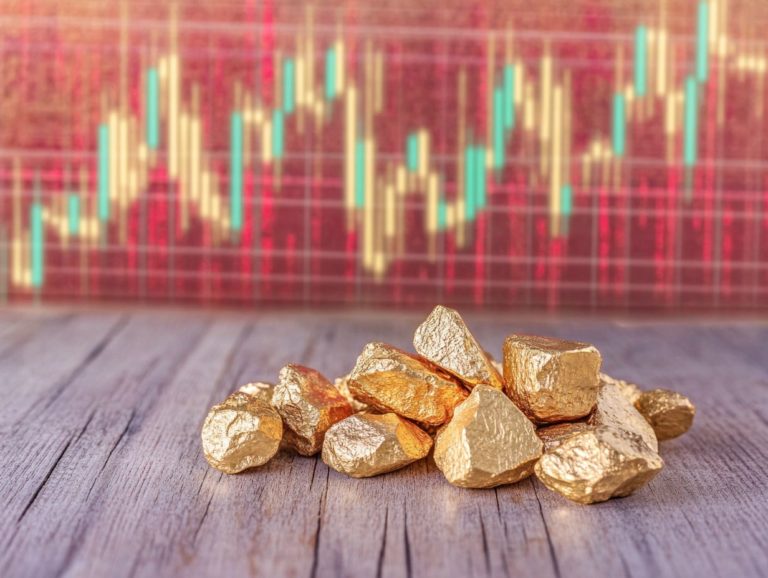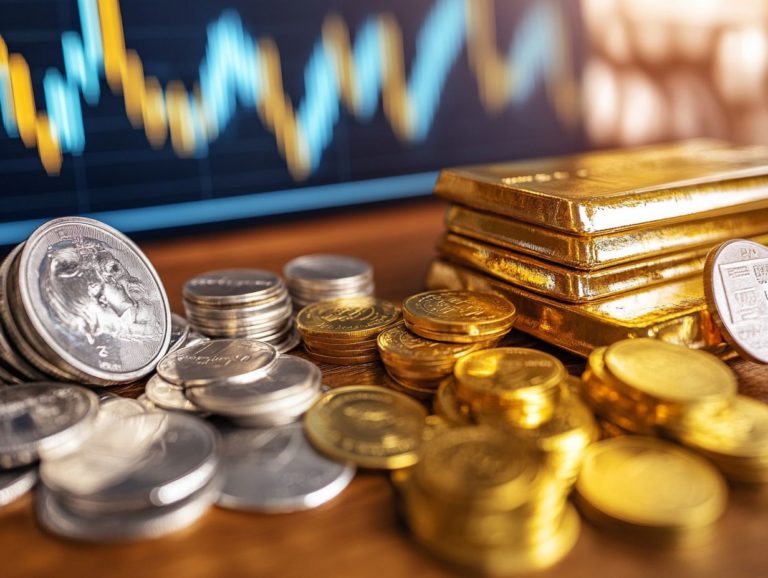How to Evaluate Precious Metal Quality
Understanding precious metals goes beyond their beauty. You need to grasp what truly makes them valuable.
This article explores the key factors that define the quality of precious metals, such as purity, composition, and certification.
You ll learn how to evaluate these metals, discover common types like gold and silver, and get essential tips for informed purchases.
Whether you re an experienced investor or a curious newcomer, this guide equips you with the confidence to navigate the world of precious metals.
Contents
- Key Takeaways:
- Factors that Determine Quality
- Methods for Evaluating Precious Metal Quality
- Common Types of Precious Metals
- Tips for Purchasing High-Quality Precious Metals
- Frequently Asked Questions
- 1. How can I evaluate the quality of precious metals?
- 2. What is the difference between karat and fineness when evaluating precious metal quality?
- 3. Can I evaluate the quality of precious metals at home?
- 4. How does the color of precious metal affect its quality?
- 5. What is the importance of market value when evaluating precious metal quality?
- 6. Are there any regulations or standards for evaluating precious metal quality?
Key Takeaways:

Understand the factors determining precious metal quality.
Familiarize yourself with evaluation methods like testing techniques.
When buying, always look for reputable sources and proper certifications.
What are Precious Metals?
Precious metals like gold, silver, and platinum are unique materials valued for centuries in jewelry and coins. Their rarity and beauty make them highly sought after.
These metals are not just for decoration; they play vital roles in industries like electronics and jewelry. They represent wealth and luxury.
Their key features like excellent conductivity and tarnish resistance make them essential in high-tech applications. Gold is often seen as a safe investment during economic downturns. Silver is both an industrial resource and a hedge against inflation.
With sustainability on the rise, recycling precious metals is becoming an exciting trend! As an investor, keep a sharp eye on market trends, especially in uncertain times.
The historical significance of these metals elevates their status in the retail and investment worlds.
Factors that Determine Quality
The quality of precious metals is influenced by several factors, with purity evaluation being key. This is indicated by karat hallmarking in gold and silver.
Analyzing alloy composition and identifying impurities are crucial. They significantly impact the value and integrity of these metals.
Purity and Composition
Purity and composition are vital for evaluating precious metals. Gold purity is measured in karats, while silver is assessed by the presence of Fine Silver and Sterling Silver.
These measurements directly affect market prices. Higher purity levels usually command greater value.
To check gold purity, use acid testing or electronic gold testers. These methods pinpoint the exact karat rating accurately.
Understanding silver’s alloy composition is important, as variations like Britannia or Mexican Silver have different purities. Assay testing confirms metal authenticity and ensures composition meets standards.
The accuracy of these evaluations builds investor confidence and shapes market valuations.
Physical Characteristics
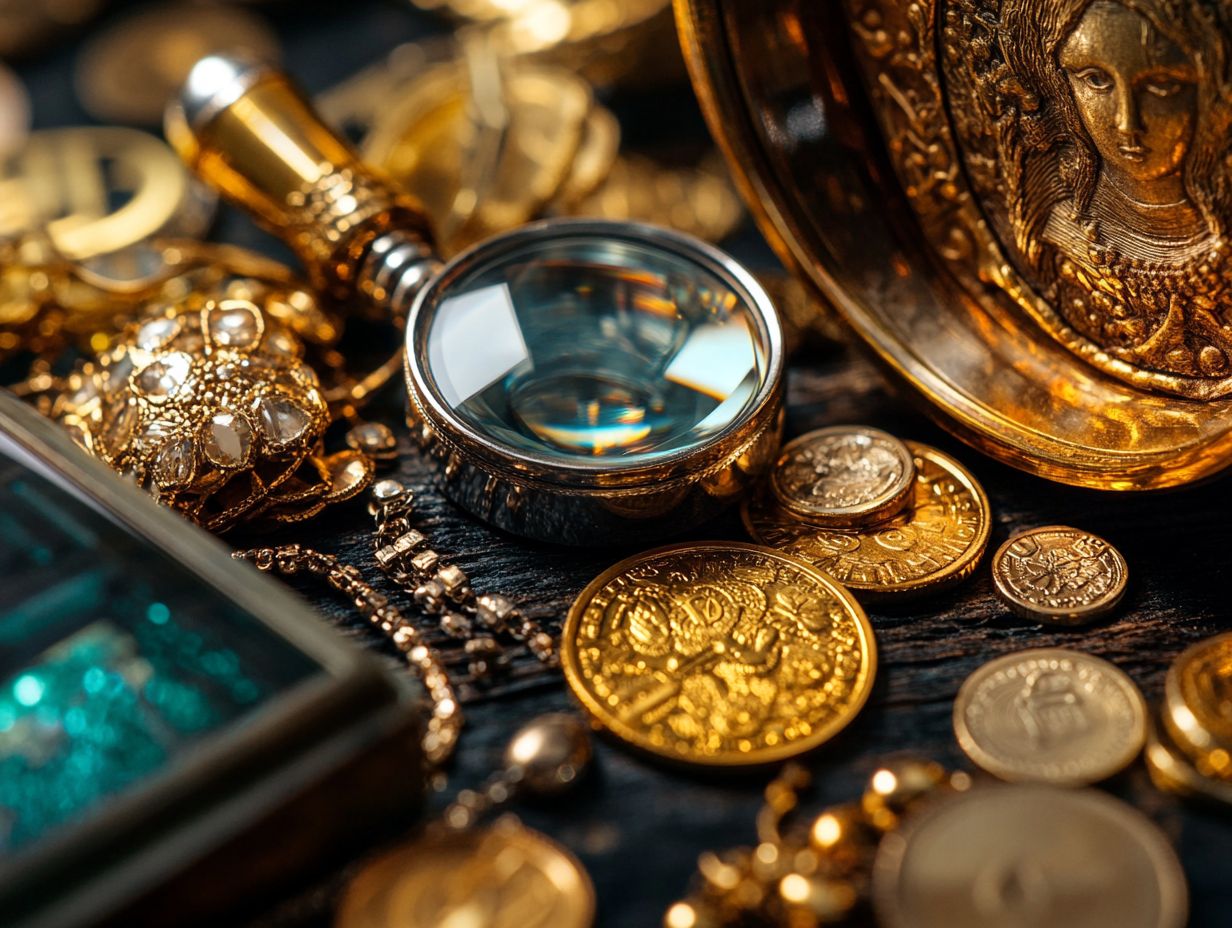
The physical characteristics of precious metals like weight, color, and luster are crucial for identification and valuation. Specific gravity testing helps confirm authenticity and aids jewelry evaluation.
These traits enhance the allure of metals and are key indicators in valuation. For instance, the weight of a metal can reveal its purity, while color variations may indicate specific alloys.
Combining visual and tactile assessments allows jewelers to gauge a piece’s investment value accurately. Understanding these properties is essential for market integrity.
Accurate identification protects buyers from counterfeit products. It fosters trust in the luxury market and ensures your investments are both secure and beautiful.
Origin and Certification
The origin and certification of precious metals are vital for maintaining market integrity. They ensure that the metals offered by jewelry dealers and manufacturers are ethically sourced and accurately represented in terms of quality and composition. This is often encapsulated in certificates of authenticity.
These certificates play a dual role; they not only confirm it s real but also provide reassurance to you, the consumer, regarding the ethical practices that underpin their sourcing. For many buyers, understanding the provenance of their precious metal purchases is essential. It connects them to a broader narrative of sustainability and ethical responsibility.
This level of transparency fosters your trust as a consumer and supports a marketplace where authentic, responsibly sourced materials can flourish. In the end, this enhances not only the value of the product but also the reputation of the brand behind it.
Methods for Evaluating Precious Metal Quality
When evaluating the quality of precious metals, you’ll find a range of testing methods at your disposal.
Traditional techniques, such as acid testing, have stood the test of time. However, modern approaches like X-ray Fluorescence (XRF) are revolutionizing the field.
With portable XRF devices, you can swiftly and accurately analyze spectral patterns to determine metal composition. This makes the assessment process both efficient and reliable.
Assaying and Testing Techniques
Assaying and testing techniques are vital for determining the quality of precious metals. You ll want to utilize a range of methods like non-destructive testing, accuracy measurements through digital scales, and traditional assay testing to ensure reliability and precision.
These methods help uphold industry standards and build consumer trust. Non-destructive testing, for instance, allows you to confirm authenticity without compromising the integrity of the item, giving both sellers and buyers peace of mind.
Meanwhile, the accurate measurements provided by digital scales ensure that weights and compositions are precisely documented. This prevents any discrepancies in pricing and quality assessments. By employing a combination of these techniques, you can uphold your commitment to excellence while delivering a transparent and trustworthy experience in the jewelry industry.
Common Types of Precious Metals
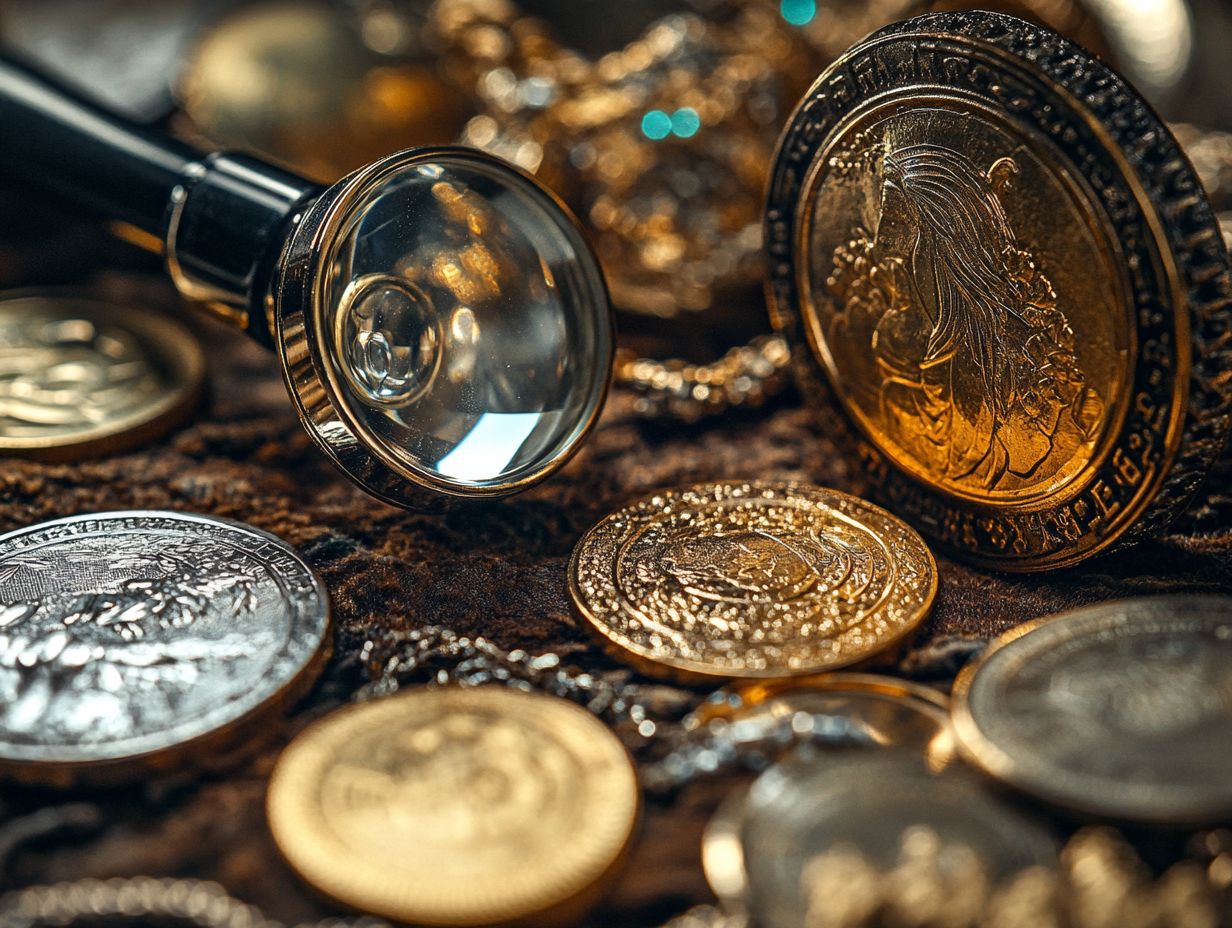
Common types of precious metals you might encounter include gold, silver, and platinum. Each of these metals boasts unique properties and serves distinct purposes in jewelry testing, investment, and various industrial applications.
Moreover, they offer remarkable opportunities for recycling, allowing you to contribute to waste reduction and enhance sustainability in the process.
Gold, Silver, Platinum, and More
Gold, silver, and platinum stand as the most esteemed precious metals, each possessing distinct characteristics that cater to various niches within the jewelry industry. Antique items often necessitate a careful checking of impurities to determine their true value effectively.
These metals are not merely celebrated for their visual allure; their durability and resistance to tarnish make them the ideal choice for creating timeless pieces. Take gold, for example it s commonly alloyed with other metals to bolster its strength while preserving its exquisite luster.
Silver, with its remarkable versatility, lends itself to a wide array of designs, appealing to a broader audience. Meanwhile, platinum, renowned for its exceptional density and rarity, commands significant value and is frequently the preferred choice for luxury jewelry.
Knowing purity levels is crucial. This diligence ensures that you receive authentic products, fostering trust within the marketplace and safeguarding your investment.
Tips for Purchasing High-Quality Precious Metals
You must consider key factors when buying high-quality precious metals.
Pay attention to the reputation of the jewelry dealers, ensuring they have a solid standing in the industry. Look for reliable testing equipment and scrutinize the accuracy of purity measurements.
Being diligent helps you get real, valuable pieces, safeguarding your investment in the finest craftsmanship.
What to Look for When Buying
When buying precious metals, it’s important to look for signs of authenticity, like the karat hallmarking in gold and silver. Reliable digital displays are also key, as they ensure transparency and help maintain market integrity.
Be aware of the risks posed by counterfeit metals that can easily fool even seasoned investors. Working with trusted dealers who provide certificates of authenticity will significantly boost your confidence in any purchase.
As a smart buyer, staying informed about market trends and fluctuations helps you make strategic decisions. Clear digital displays provide real-time price updates and enhance your awareness, allowing you to avoid potential pitfalls in the complex world of precious metal investments.
Keep these factors in mind to protect your financial interests today!
Frequently Asked Questions
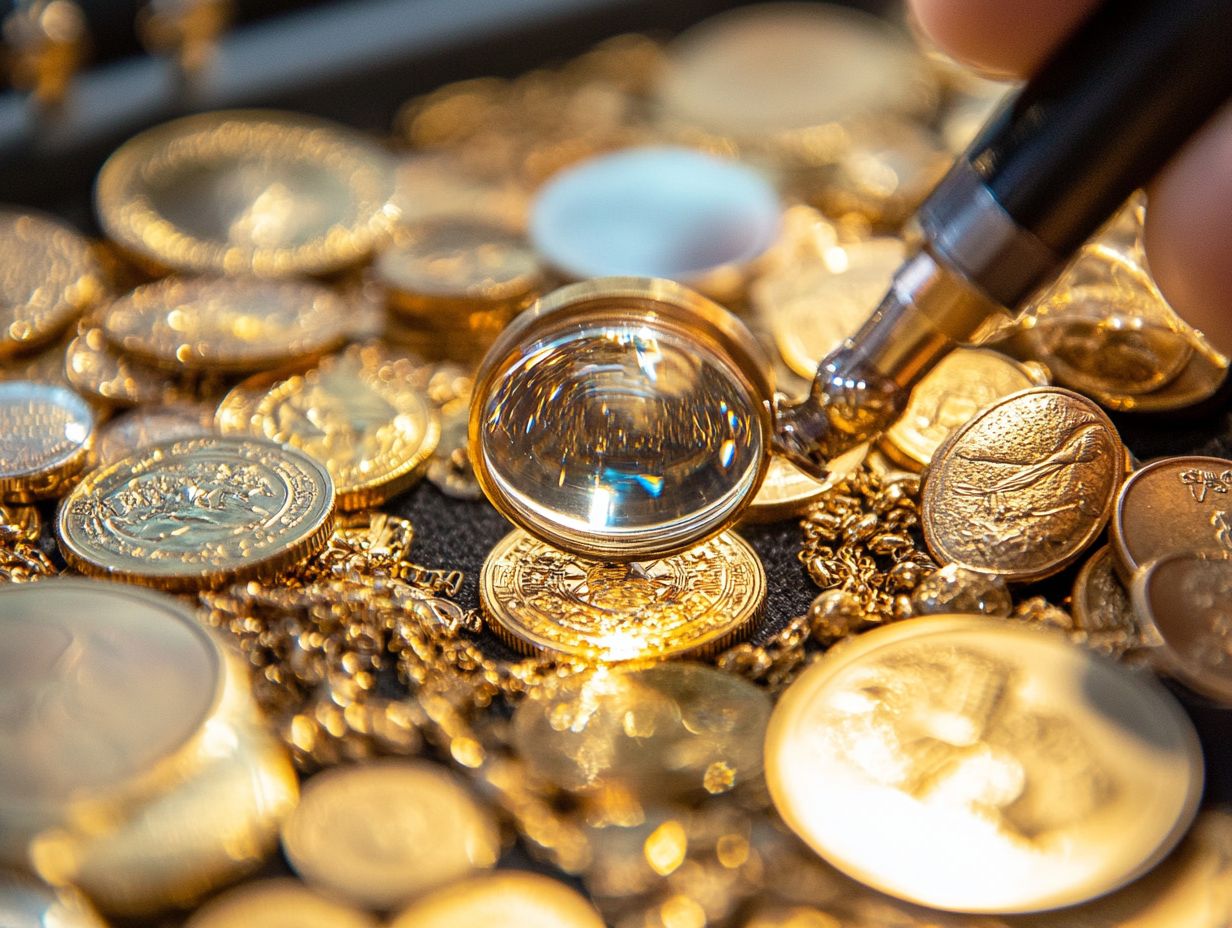
1. How can I evaluate the quality of precious metals?
One way to evaluate precious metal quality is by checking its purity level, measured in karats or parts per thousand. You should also consider the criteria for precious metals investment, including weight, density, appearance, and durability of the metal.
2. What is the difference between karat and fineness when evaluating precious metal quality?
Karat measures purity on a 24-point scale, with 24k being the highest purity. Fineness is expressed in parts per thousand to indicate purity, with 999 considered pure. For example, 18k gold has a fineness of 750, meaning it is 75% pure gold.
3. Can I evaluate the quality of precious metals at home?
Yes, you can perform a few simple tests at home to evaluate precious metals. These include a magnet test, a scratch test, and a density test. However, for a more accurate evaluation, it’s best to have a professional appraiser or jeweler assess the metal.
4. How does the color of precious metal affect its quality?
The color of precious metal can indicate its purity and quality. For example, platinum is naturally white and usually more valuable than white gold, which is often alloyed with other metals to achieve its color. However, color alone should not be the sole factor in evaluating quality.
5. What is the importance of market value when evaluating precious metal quality?
Market value plays a significant role in determining the quality of precious metals. Current market value is influenced by demand, availability, and the metal’s popularity. While high market value can indicate high-quality precious metal, it should not be the only factor considered.
6. Are there any regulations or standards for evaluating precious metal quality?
Yes, various regulations and standards define the quality of precious metals. For example, the Federal Trade Commission’s Guides for the Jewelry, Precious Metals, and Pewter Industries require metal content disclosure and set purity standards. Various industry organizations also have their own standards, such as the American Society for Testing and Materials (ASTM) and the International Organization for Standardization (ISO).


